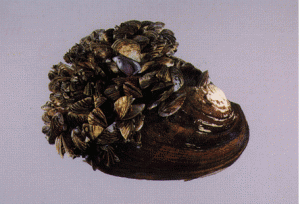“In conclusion…there is a high risk of [zebra mussels] not only surviving in some parts of Okanagan Lake, but a high potential for massive infestations.” – Gerald L. Mackie, 2010
Sometimes we need to do environmental triage – focusing on what’s most important, and what approaches are likely to succeed.

When water conditions are right, zebra mussels reproduce rapidly and can completely cover the shells of native mussels.
Lately I’ve been trying to get a better understanding of the situation with mussels in the lakes. There are two of immediate concern – a species native to the Okanagan, the Rocky Mountain ridged mussel, on the verge of local extinction, and an invasive – the zebra mussel, which is spreading rapidly across North America and heading this way.
These species are an example of how we grapple with management approaches and trade-offs, and the best course for protecting biodiversity for the whole ecosystem. Continue reading

